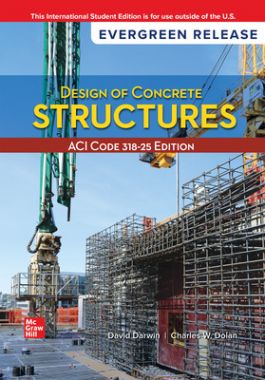Design of Concrete Structures: 2025 Release ISE
1264977395
·
9781264977390
For over a century, Design of Concrete Structures has been the authoritative source for the behavior of reinforced concrete structures and design approaches in accordance with the ACI 318 Building Code. The 2025 ACI Building Code contains over 100 im…
Read More
Request Review Access
Request More Info
Receive via shipping:
Colour, print bound version of the complete text
1. Introduction
2. Materials
3. Design of Concrete Structures and Fundamental
Assumptions
4. Flexural Analysis and Design of Beams
5. Shear and Diagonal Tension in Beams
6. Bond, Anchorage, and Development Length
7. Serviceability
8. Analysis and Design for Torsion
9. Short Columns
10. Slender Columns
11. Analysis, Idealization, and Preliminary Design of Reinforced Concrete Beams and Frames
12. Analysis and Design of One-Way Slabs
13. Analysis and Design of Two-Way Slabs
14. Walls
15. Footings and Foundations
16. Retaining Walls
17. Strut-and-Tie Method
18. Design of Reinforcement at Joints
19. Concrete Building Systems
20. Seismic Design
21. Anchoring to Concrete
22. Prestressed Concrete
23. Yield Line Analysis for Slabs
24. Strip Method for Slabs
Appendix A - Design Aids
Appendix B - SI Conversion Factors: Inch-Pound Units to SI
Units
Author Index
Subject Index
2. Materials
3. Design of Concrete Structures and Fundamental
Assumptions
4. Flexural Analysis and Design of Beams
5. Shear and Diagonal Tension in Beams
6. Bond, Anchorage, and Development Length
7. Serviceability
8. Analysis and Design for Torsion
9. Short Columns
10. Slender Columns
11. Analysis, Idealization, and Preliminary Design of Reinforced Concrete Beams and Frames
12. Analysis and Design of One-Way Slabs
13. Analysis and Design of Two-Way Slabs
14. Walls
15. Footings and Foundations
16. Retaining Walls
17. Strut-and-Tie Method
18. Design of Reinforcement at Joints
19. Concrete Building Systems
20. Seismic Design
21. Anchoring to Concrete
22. Prestressed Concrete
23. Yield Line Analysis for Slabs
24. Strip Method for Slabs
Appendix A - Design Aids
Appendix B - SI Conversion Factors: Inch-Pound Units to SI
Units
Author Index
Subject Index
For over a century, Design of Concrete Structures has been the authoritative source for the behavior of reinforced concrete structures and design approaches in accordance with the ACI 318 Building Code. The 2025 ACI Building Code contains over 100 important technical changes. These changes address development of reinforcement, higher strength reinforcement, column design, concrete breakout capacity, and shear capacity. The changes have profound and important impacts on the design of concrete structures.Design of Concrete Structures by Darwin and Dolan presents current concrete behavior theory and updated code-based design rules. The text and illustrated examples are essential for faculty members, students, and practitioners to understand current concrete design. New homework problems are included. The work serves as a current source for design and a career resource on the development of concrete design theory.

